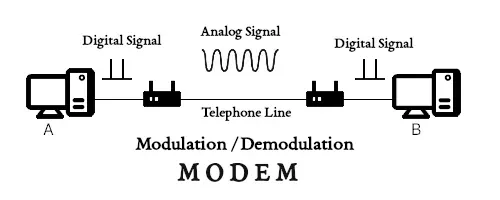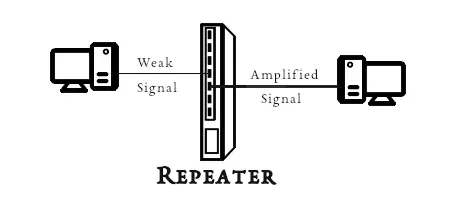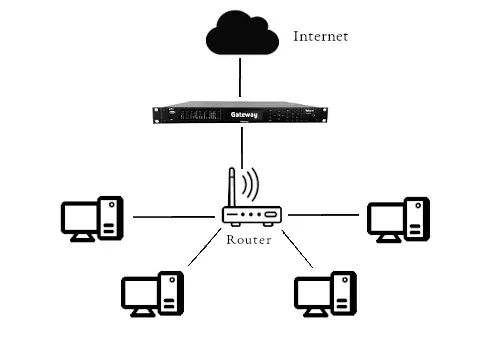In the contemporary digital ecosystem, network devices serve as indispensable components driving seamless communication and connectivity.
Network devices, ranging from routers and switches to modems and firewalls, facilitate the seamless transfer of data across the vast landscape of the internet and form the backbone of our interconnected world.
Let's delve into the world of network devices to understand their functions and significance in simpler terms for Kerala PSC degree level examinations.
Network Devices
☰Table of Contents
What are Network Devices?
Network devices, also known as networking hardware, are physical devices that allow hardware on a computer network to communicate and interact with one another.
Different Types of Network Devices
The most common types of network devices are:
- NIC
- Modem
- Repeater
- Hub
- Bridge
- Switch
- Gateway
Let’s discuss all these devices in detail.
NIC (Network Interface Card)
It is a hardware component installed in the computers, servers, and other networked devices that can be used to connect the computer to the network.
It is also known as ethernet card, network adapter, network interface controller, or LAN adapter.
NIC has a unique id that is written on the chip, and it has a connector to connect the cable to it. The cable acts as an interface between the computer and the router or modem.
NIC card is a Layer 2 device so it works on both the physical and data link layers of the network model.
Through the transmission and reception of data packets, NICs enable devices to send and receive information across the network, ensuring seamless connectivity and data exchange. It can support a transfer rate of 10,100 to 1000 Mb/s.
There are 2 types of NICs. They are:
- Internal Network Cards: requires network cables to provide network access, installed in the motherboard.
- External Network Cards: no network cable is required for the network access. They can be Wireless and USB based.
Modem
A modem is a network device that modulates and demodulates analog carrier signals to encode and decode digital data for processing. It can be wired or wireless.
Repeater
A repeater is a network device used to regenerate or amplify signals in a network. In simpler terms, think of it as a "signal booster" for data transmission.
When data travels across a network, it can weaken over long distances because of signal loss or degradation. A repeater receives these weakened signals, cleans them up, and retransmits them at their original strength, effectively extending the range of the network.
A repeater which operates at the physical layer helps to maintain the integrity and quality of signals as they travel across a network, ensuring that data reaches its intended destination without loss or distortion.
They are commonly used in Ethernet and telecommunications networks to overcome limitations imposed by cable length and signal degradation.
Hub
A hub is a network device that serves as a central connection point for multiple devices in a local area network (LAN). In simpler terms, you can think of a hub as a "traffic cop" for data within a network.
When a device connected to a hub sends data, the hub broadcasts that data to all other devices connected to it.
This means that all devices connected to the hub receive the data, regardless of whether they are the intended recipients or not. This broadcasting method is known as "collision domain," where multiple devices share the same communication channel, potentially causing collisions when they attempt to transmit data simultaneously.
In other words, the hub acts basically as a multi-port repeater which cannot filter data and transmits data to all devices connected to it.
They are suitable for small networks or temporary setups. Due to their limitations, they are less commonly used in modern network environments.
Types of Hub
There are primarily three types of hubs:
a. Active Hub
They are powered hubs that can regenerate and amplify signals before forwarding them to connected devices. They contain electronic circuitry that allows them to clean up and strengthen signals, enabling data transmission over longer distances.
Active hubs are typically used in larger networks where signal regeneration is necessary to maintain network performance and are used to extend the maximum distance between nodes of a network.
b. Passive Hub
Also known as unpowered hubs, do not require external power and simply serve as connection points for devices in a network. They do not regenerate or amplify signals, which means they rely solely on the incoming signal strength.
Passive hubs are usually used in smaller networks or temporary setups, where signal degradation is not a significant concern.
c. Intelligent Hub
These hubs combine the features of active hubs with additional functionality, such as port monitoring, management, and diagnostics. They have built-in intelligence to monitor network traffic, detect errors, and manage bandwidth more effectively.
Intelligent hubs are commonly used in larger networks where advanced management capabilities are required for efficient network operation.
Bridge
A bridge is a network device used to connect two or more separate network segments together and manage the flow of data between them.
In simpler terms, you can think of a bridge as a "repeater" that operates at the data link layer (Layer 2) and links two distinct parts of a network.
Working of a Bridge
Bridges are used to divide an extensive network into smaller segments, known as collision domains. When a data packet arrives at a bridge, the bridge examines the MAC (Media Access Control) address of the packet to determine its destination.
If the destination MAC address is located on the same network segment as the source, the bridge does not forward the packet and instead discards it. However, if the destination MAC address is on a different network segment, the bridge forwards the packet to that segment.
As data packets pass through the bridge, it learns the MAC addresses of devices connected to each network segment. It then builds a table, known as the MAC address table or forwarding table, which maps MAC addresses to the corresponding network segments.
Once the bridge has learned the MAC addresses of devices on each network segment, it can intelligently forward data packets only to the network segment where the destination device is located. This helps minimize unnecessary network traffic and improves overall efficiency.
Bridge is also used for interconnecting two LANs working on the same protocol. It has a single input and single output port, thus making it a 2 port device.
However, with the advent of more advanced network devices like switches, bridges are less commonly used in modern network architectures.
Switch
Switches operate at the data link layer of the OSI model, serving as intelligent network devices that facilitate communication within local area networks (LANs).
Unlike hubs, which simply broadcast data to all connected devices, switches intelligently forward data only to the intended recipient based on the destination MAC address.
This makes switches more efficient in managing network traffic and reduces the likelihood of collisions.
How Switches Work
When a device sends data to the switch, the switch learns the MAC address of the sending device by examining the source MAC address in the data frame. It then associates this MAC address with the port through which the data arrived.
The switch maintains a table, often referred to as a MAC address table or forwarding table, which maps MAC addresses to the ports on the switch.
This table is used to determine the outgoing port for each incoming data frame based on the destination MAC address.
When the switch receives a data frame, it looks up the destination MAC address in its MAC address table to determine the outgoing port.
If the MAC address is found in the table, the switch forwards the data frame only to the port associated with that MAC address.
If the MAC address is not in the table, the switch broadcasts the data frame to all ports except the incoming port (flooding), allowing the destination device to respond and update the MAC address table.
Types of Switches
There are several types of switches used in networking, each offering different levels of control, features and functionalities. Here are some of the most common types:
- Unmanaged Switches: basic plug-and-play devices that simply forward data packets between connected devices without the need for configuration. They are typically used in small networks or home environments where simplicity and ease of use are prioritized.
- Managed Switches: these offer advanced features and capabilities that allow network administrators to configure, monitor, and manage the switch remotely. They provide granular control over network traffic, VLANs (Virtual Local Area Networks), QoS (Quality of Service), port mirroring, and security settings. Managed switches are commonly used in medium to large-scale networks where customization and optimization of network performance are essential.
- Layer 2 Switches: operate at the data link layer (Layer 2) of the OSI model and make forwarding decisions based on MAC addresses. They are capable of segmenting LANs into multiple collision domains and VLANs, facilitating efficient data transmission within the network.
- Layer 3 Switches: also known as multilayer switches, operate at both the data link layer (Layer 2) and the network layer (Layer 3) of the OSI model. Besides MAC address forwarding, layer 3 switches can perform routing functions, allowing them to make forwarding decisions based on IP addresses. This enables them to route traffic between different subnets or VLANs, improving network efficiency and scalability.
- PoE Switches: Power over Ethernet (PoE) switches are equipped with Power over Ethernet functionality, which allows them to deliver power to connected devices such as IP phones, wireless access points, and IP cameras over the Ethernet cable. PoE switches eliminate the need for separate power sources for these devices, simplifying installation and reducing clutter.
Switches are the fundamental components of modern Ethernet networks and are widely used in both small-scale and enterprise-level network deployments.
Router
Imagine routers as traffic directors on a bustling highway. Just like these directors guide vehicles to their destinations, routers direct data packets between different networks.
They determine the most efficient paths for data to travel, ensuring that information reaches its intended destination swiftly and securely.
That is, a router is a device like a switch that routes data packets based on their IP addresses.
Operating at the network layer of the OSI model, routers normally connect LANs and WANs and utilize complex algorithms and a dynamically updating routing tables to determine the optimal paths for data transmission.
Through this process, routers enable efficient and reliable communication between disparate networks, ensuring that data reaches its destination promptly and securely.
The router divides the broadcast domains of hosts connected through it.
Gateway
A gateway is a network device that serves as an interface between different networks, allowing communication and data exchange between them.
In simpler terms, you can think of a gateway as a "doorway" or "bridge" that connects two or more networks with different communication protocols, architectures, or technologies.
Gateways are more complex than switches or routers. They are also called protocol converters and can operate at any network layer.
Functions of a Gateway
1. Protocol Conversion
One of the primary functions of a gateway is to facilitate communication between networks that use different communication protocols.
For example, it can translate data between Ethernet and Wi-Fi networks, or between TCP/IP and legacy serial protocols.
2. Address Translation
They often perform address translation to enable communication between networks with different addressing schemes.
For eg:, a gateway can translate between IP addresses and MAC addresses to facilitate communication between devices on a LAN and the internet.
3. Data Routing
Gateways route data packets between networks based on network addresses or other routing information. They determine the most efficient path for data to travel from the source network to the destination network, ensuring reliable and timely delivery of data.
4. Security
Gateways can also serve as security checkpoints, enforcing access control policies and filtering incoming and outgoing traffic to protect the network from unauthorized access, malware, and other security threats.
Summary
- Repeater – operates on the physical layer, used to regenerate the signal over the network before it becomes too weak.
- Hub – physical layer device that recreates the bit, boosts its energy strength, and transmits the bit onto all the other interfaces.
- Bridge – data link layer networking device. A repeater with the added functionality of filtering content by reading the MAC addresses of the source and destination.
- Switch – data link layer network device, acts as a multiport bridge with a buffer and design that can improve its efficiency and performance.
- Router – network layer device similar to a switch, routes data packets based on their IP addresses.
- Gateway – network device that connects two networks that use different transmission protocols.
- Modem – modulates and demodulates analog carrier signals to encode and decode digital data for processing.
- NIC – Layer 2 hardware component that can be used to connect the computer to the network.
📝 SideNotes:
- The Gateway Internet Access Service (GIAS) of India was launched on August 15, 1995 in Bombay, Delhi, Calcutta and Madras.
Thanks for reading!!!















Post a Comment
Post a Comment